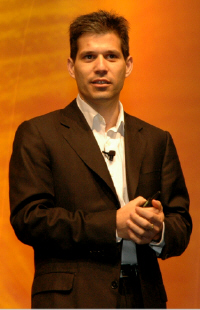No trash talking from SAP's Agassi


Agassi was quick to point out the SAP's enterprise application license revenue share compared to it closest competitors. "At the end of the day you have SEC reporting to see who sold what. Last quarter we had 63 to 64 percent out of the three big players. Before Oracle acquired Peoplesoft, we have 30 percent more share points than Oracle. Now it's 35 percent, $20 billion [Oracle dollars] later," Agassi said. No trash talking, just the facts, he added.
For SAP and others building their next-generation application platforms, the shift to Java/SOA is well underway. But, as AMR's Bruce Richardson said in my interview with him yesterday, the build and rollout of these SOA platforms to customers will take several years.
Agassi claimed that SAP was "way ahead of anybody else in execution" on delivering an SOA platform, with live installations at customer sites. Some customers are using SAP's enterprise services on top of older versions of SAP's platform, such as R3, but it's not the Holy Grail of pure NetWeaver, Enterprise Service Architecture SOA.
NetWeaver 2004s (Agassi said doesn't know what the 's' stands for) currently has a repository of 3,000 enterprise services and about 1000 ISVs developing for the platform. The company is also working with customers and partners on business semantics, coming up with standardized ways to define terms like customer, supplier, invoice, etc. He knocked Oracle, which he said has ended up with lots of words through its acquisitions, but no "language." Oracle Fusion, due in 2008, is supposed to solve its polyglot problem.
Agassi was pointedly asked by an audience member from the oil and gas company Shell how to get to the brave new SOA world, in the context of having spent hundreds of millions on existing SAP systems. Agassi said that customers pick their up pace, and migrate over a span of four or five years. "Others will migrate to a single instance first and inherit the new architecture. Both [approaches] are valid. Somewhere in between lies the truth for every company," Agassi said. But, most will take several years to roll out, as Richardson noted.
At the other end of the scale, Agassi said that SAP has developed business solutions that will allow a small business to set up on it software in one minute. "We've never had this kind of capability. Then imagine what you can do for the mid and large size companies," Agassi said. He didn't offer any specifics. Just as consumer Web services are influencing enterprise applications from the ground up, SAP may have figured out how to improve the usability of its products by a similar tactic, rather than the usual top down approach to serving smaller markets.
The ultimate value proposition of an SOA platform, according Agassi, gaining a 10x cost reduction and 10x performance gain in query speed. It's a change by order of once every 20 years, he said, driven by advances in underlying technologies and a need to keep up with a rapid the pace of change. "Flexibility becomes a competitive advantage," Agassi said. He gave an example of customer DaimlerChrysler's flexibility and manufacturing optimization scheme. DaimlerChrysler wants doors five-percent cheaper every year from its supplier, and just in time deliver with the right feature set and connecting the right color to the right door, and having the capability to change orders 90-minutes before they ship. "Growth comes from ability to leverage relationship," Agassi stated. "We see a whole new set of fluid processes that create social networks in organizations and deal with events faster, and reuse common services to deliver more and faster and cheaper innovation.
He sees the CIO role transition toward a CPIO (Chief Process Innovation Officer) who makes sure all the processes and connections are working well, and an IT chief who focuses on reducing costs, consolidating systems to free up budget for the CPIO. In Agassi's new world you have new kind of roles, or job titles, consolidators, repository keepers, composers, and disruptive innovators.
"We are not just thinking about SAP's 64-percent market share. We have to raise the whole industry up to next generation," Agassi concluded. For SAP raising the industry up is about figuring out the right platform interfaces and building a massive catalog of applications, micro-verticals that SAP won't do itself. This is similar to the way salesforce.com is building a platform based on its core CRM, forms-based software. And like Salesforce.com, SAP's NetWeaver is open and and monetizable by third-parties as long as they buy into the respective platforms.